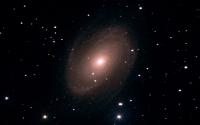|
- What if a star was a grain of sand?
In his lecture series on Cosmology (see my Education page), Professor Mark Whittle helps people visual how many stars are in the galaxy by describing how big a box you would need to hold them, if each star was the size of a grain of sand. He did not provide the underlying math, so I attempted to derive the result and found the following:
If you assume that the Milky Way has 300 billion stars in it (current estimates are 200-400 billion), and you make each of them the size of an average grain of sand (0.25mm in diameter), and throw them into a box, you would need a box that is almost 4 cubic meters in volume. That is a cube having dimensions of 1.6 meters (5.2 feet) on a side...filled to the top with our "sand stars"!
Let's expand this model to the entire universe and assume that there are approximately 300 billion galaxies out there (probably in the right order of magnitude), with an average star population of our Milky Way (which is considered fairly average). If you turned all those stars into sand, you would need a box with a volume of just under 1,200 cubic kilometers to hold all those stars. That translates to a cube having dimension of ~10.6 kilometers (~6.6 miles) on a side!
P.S. In his lecture, Professor Whittle said our galaxy - filled with "sand stars" - would fit in a cube that is 1 meter on a side. As to why my calculation is a bit larger, my guess is he may - more accurately - not have assumed uniformly sized spheres (since actual stars vary in size), allowing the smaller stars to pack a bit more neatly among the voids of the bigger stars and improving volume efficiency in his model. Still, we're in the same ballpark!
|
|
